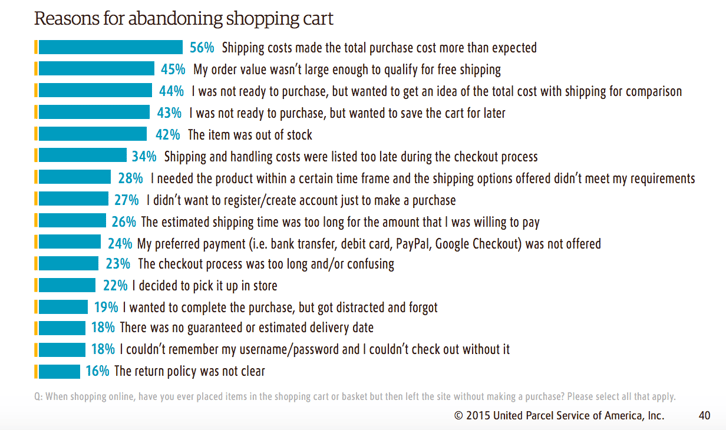How your Shipping Policies are Causing Cart Abandonment (and What you can do to Fix it)
Online retailers spend significant time optimizing their merchandising, discovery, and their overall site experience in order to maximize purchase competition. Yet nearly 70% of online shopping carts are abandoned. The main culprit of cart abandonment? It’s your shipping experience.
Research from UPS and comScore reveals that six of the top 10 reasons for cart abandonment are shipping related:
Most notably:
- 56% of online shoppers abandoned their shopping cart because shipping costs made the total purchase more than expected.
- 45% didn’t complete their purchase because the order value wasn’t large enough to qualify for free shipping.
- 34% felt shipping and handling costs were listed too late in the checkout process.
There’s a theme here: customers don’t like to be surprised by shipping prices.
The good news is that you can fight cart abandonment by following a few simple best practices that will help cart conversion and create a great consumer journey.
- 1. Show your shipping costs early in the process. One of the easiest ways to make sure your customers know what they’re spending on shipping is by including the shipping cost directly on the product page. For new customers this can be easily achieved by adding a zip code field on the product page or in the shopping cart rather than requiring a registration wall prior. Shipping cost transparency will lead to higher rates of purchase completion because the consumer will know what they’re paying from the get-go, with no surprises and minimal frustration.
- 2. Use a flat rate for shipping. Flat rate shipping costs are great because they help the retailer recoup some of the distribution costs while incentivizing the customer with clear, subsidized shipping. With a standard shipping price, regardless of item type or size, your customers will always know what to expect when it comes time to checkout.
- 3. Be selective on what ships free. Use a strategy of selective free shipping to drive consumer behavior. By understanding the true cost of shipping at an item level, retailers can identify key items that have lower shipping costs. Depending on your product mix, you may decide to extend the free shipping offer across an entire category of products that are high margin and low cost—for example, all jewelry and fashion accessories ship for free, for a retailer that sells clothing and accessories.
- 4. Test free shipping thresholds. There’s no universal best threshold for free shipping thresholds. Average order size, customer location, competitive options and buying patterns all impact where the appropriate breakpoint is for your business. Use performance marketing campaigns and attribution tracking to A/B test the behavior of your specific consumers.
- 5. Give customers low cost and expedited options, just not together. Different customers will be optimizing for different needs: pricing, service, and home delivery options. By giving customers options at the point-of-purchase you give these customers the option to self-select for their preferences.
- 6. Consider one-click solutions such as Visa-Pay and PayPal. Twenty-seven percent of customers say they don’t want to register or create an account to complete a purchase. By leveraging one of the one-click solutions such as PayPal or Visa Pay there are two benefits: reducing the number of steps to purchase, and accessing all the information to accurately pricing shipping up front.
Do you have other examples on improving the in-cart shipping experience? We’d love for you to tweet them to us @ShipHawk. And as always, contact us if you’d like to learn more about how ShipHawk can help you increase your shopping cart conversions.

